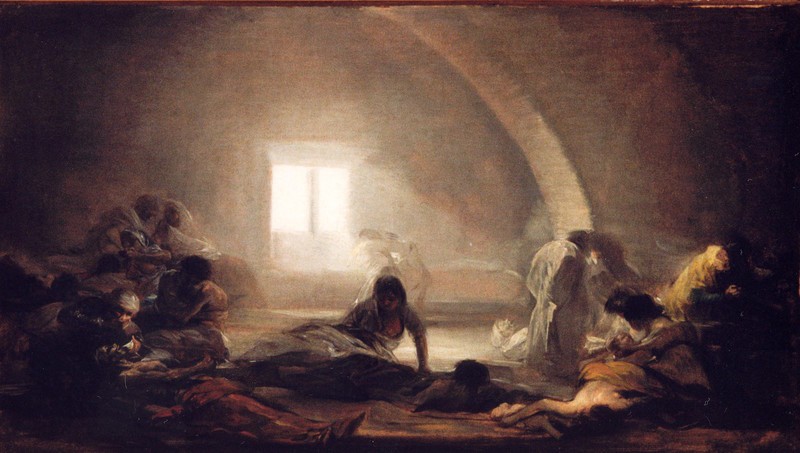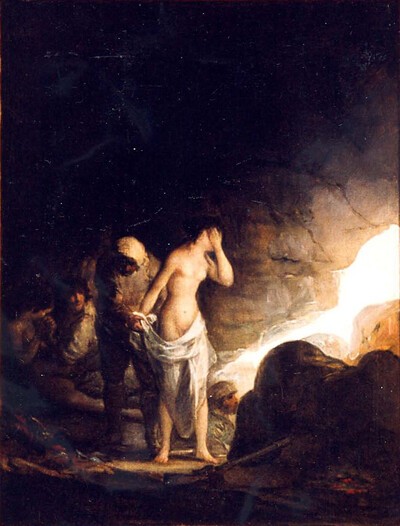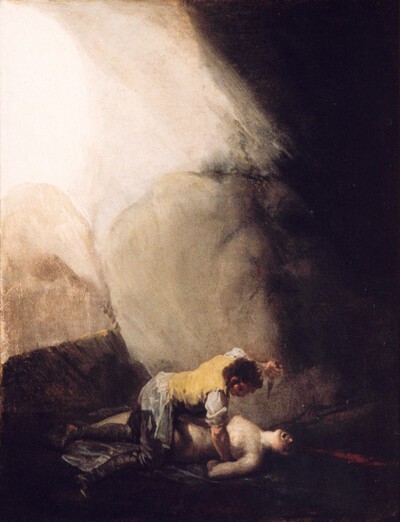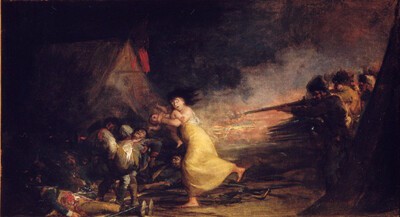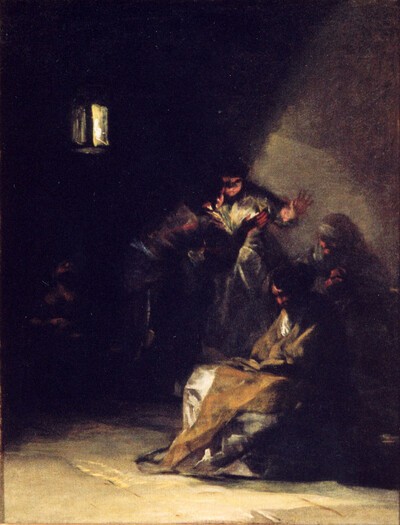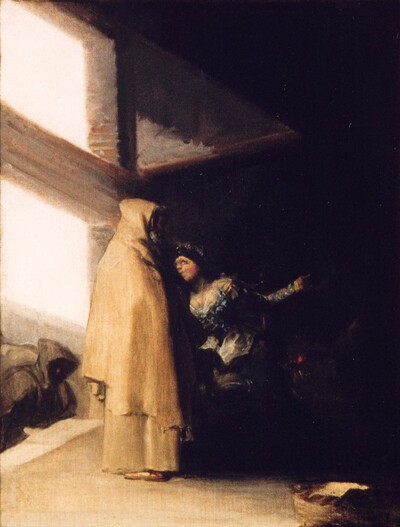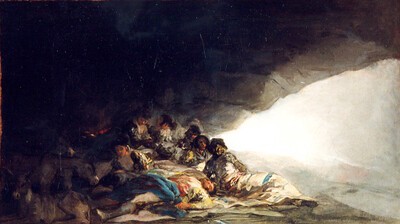- Cronología
- Ca. 1808 - 1810
- Ubicación
- Marquis of La Romana Collection, Madrid, Spain
- Dimensiones
- 32.5 x 57.3 cm
- Técnica y soporte
- Oil on canvas
- Reconocimiento de la autoría de Goya
- Documented work
- Titular
- Marquis of La Romana Collection
- Ficha: realización/revisión
- 11 May 2010 / 15 Jun 2023
- Otros títulos:
-
Interior of a Plague Hospital (Interior de un hospital para apestados)
Interior of a Hospital (Interior de hospital)
The complete series of eleven paintings was acquired from Goya by the Majorcan collector Juan de Salas, father of Dionisia Salas y Boxadors, who was married to Pedro Caro y Sureda (Palma de Mallorca, 1761-Cartaxo, Portugal, 1811), III Marquis of La Romana.
The painting was inherited by its current owners.
Due to its dimensions and to the use of an orange-coloured preparation on the canvas, this work can be connected to Vagabonds Resting in a Cave and Shootings in a Military Camp.
Set in a hospital room containing a number of large arched structures, this scene shows a group of people suffering the terrible effects of a plague epidemic.
A golden light illuminates the space and reveals the distressing situation within, as some of the sick try to help the most seriously ill and even the dying, giving them medicine to drink. They go about their work despite the pestilent atmosphere, which in some cases forces them to hold their noses with their fingers. This gesture is repeated in the figure walking through the macabre landscape of corpses in etching no. 62, The beds of death, of the Disasters of War series.
Here, the figures are painted using rapid, fine brushstrokes and their faces are treated only superficially, in many cases giving them a phantasmagorical aspect which portends the approach of death. The atmosphere evoked by Goya in this painting is reminiscent of two of the works which the artist made during his stay in Cádiz: Yard with Lunatics and Interior of a Prison.
This work can also be related to some of the images in the Disasters of War series especially numbers 48 to 64. In these etchings, Goya captured scenes of solidarity among those suffering the terrible consequences of war such as hunger and sickness. Their haggard, skeletal faces reflect the widespread suffering, and, just as in Plague Hospital, leave little room for hope.
The same physical fragility of many of the people in the painting can also be see in the figure of the resurrected man in The Miracle of San Antonio of Padua, in the chapel of San Antonio de la Florida (1798, Madrid).
-
Goya 1900Ministerio de Instrucción Pública and Bellas ArtesMadrid1900consultant editors Aureliano de Beruete, Alejandro Ferrant, Marqués de Pidal and Ricardo Velázquez. May 1900cat. 55
-
Pinturas de GoyaMuseo Nacional del PradoMadrid1928consultant editor Fernando Álvarez de Sotomayor. From April to May 1928cat. 12
-
Goya. El Capricho y la Invención. Cuadros de gabinete, bocetos y miniaturasMuseo Nacional del PradoMadrid1993from November 18th 1993 to February 15th 1994. Exhibited also at the Royal Academy of Arts, London, March 18th to June 12th 1994 and The Art Institute of Chicago, Chicago, July 16th to October 16th 1994, consultant editors Manuela B. Mena Marqués and Juliet Wilson-Bareaucat. 80
-
Francisco de Goya: Maleri, Tegning, GrafikkNasjonalgallerietOslo1996from 10th to April 14th 1996cat. 24
-
Goya: Prophet der ModerneAlte NationalgalerieBerlin2005from July 13th to October 3th 2005. Exhibitied also at the Kunsthistorischemuseum, Vienna, October 18th 2005 to January 8th 2006, consultant editor Manuela B. Mena Marquéscat. 75
-
Goya en tiempos de guerraMuseo Nacional del PradoMadrid2008consultant editor Manuela B. Mena Marqués, from April 14th to July 13th 2008cat. 54
-
GoyaBasle2021p. 222
-
L'œuvre peint de Goya. 4 volsParís1928-1950p. 226, cat. 192
-
Vie et ouvre de Francisco de GoyaParísOffice du livre1970p. 263, cat. 919
-
BarcelonaPolígrafa1970vol. I, pp. 294, cat. 353
-
L’opera pittorica completa di GoyaMilanRizzoli1974pp. 122, il. XXXVII, cat. 493
-
Goya. Arte e condizione umanaNaplesLiguori editore1990pp. 150, 155, il. XI
-
Goya. El capricho y la invención. Cuadros de gabinete, bocetos y miniaturasMadridMuseo del Prado1993pp. 283, 284, 285 (il.) y 286, cat. 80
